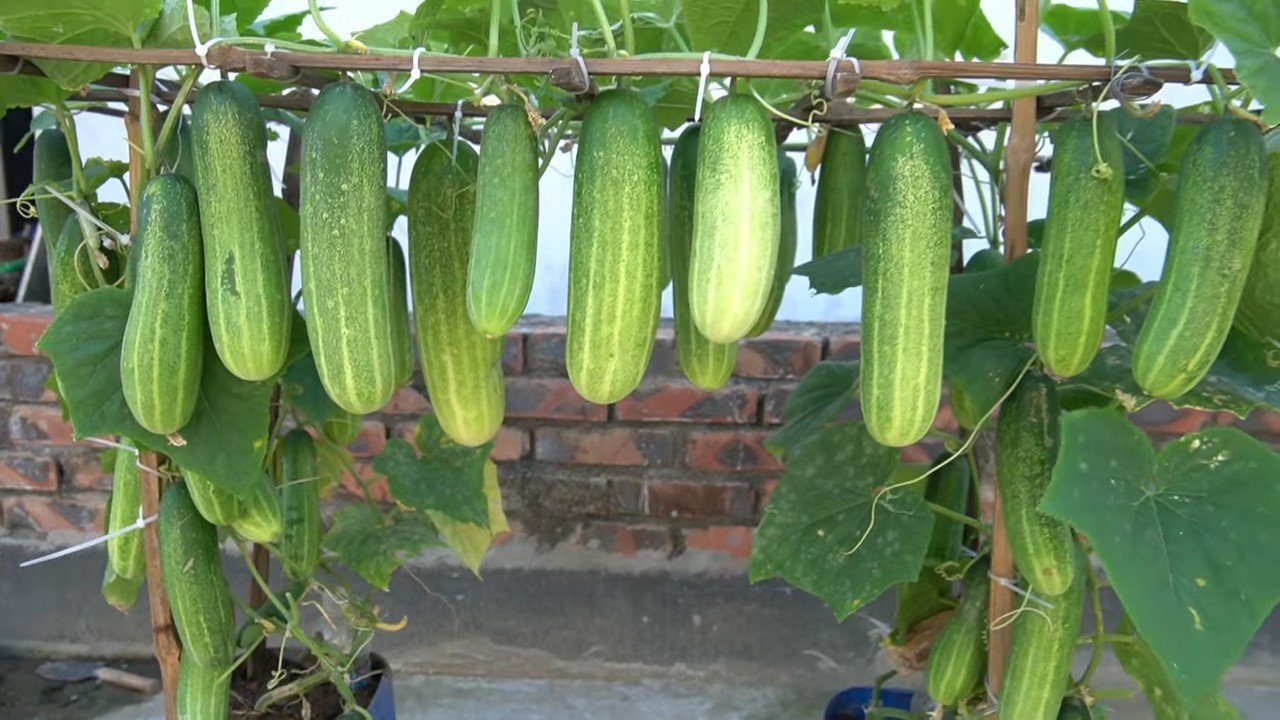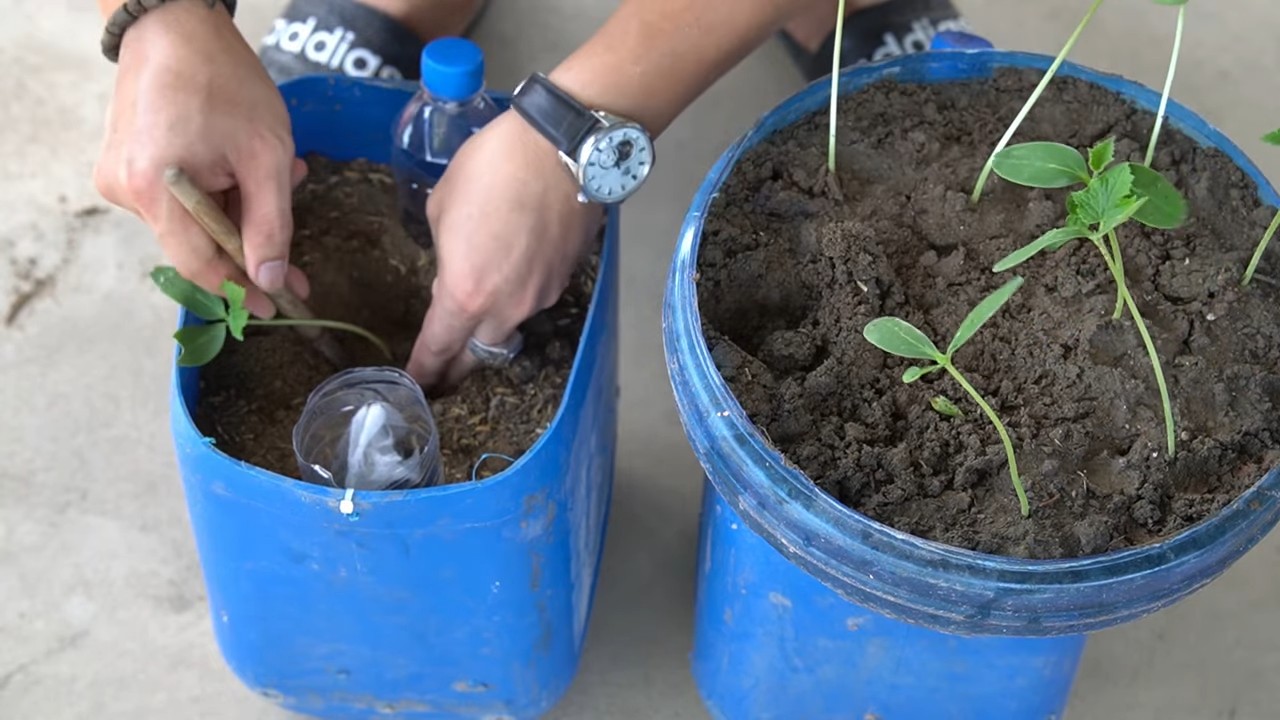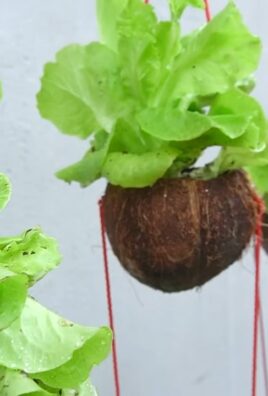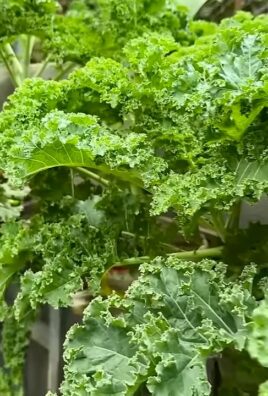Growing Cucumbers in Containers: Imagine biting into a crisp, refreshing cucumber you nurtured from seed to salad, all within the cozy confines of your balcony or patio! Sounds idyllic, right? Well, it’s absolutely achievable, even without a sprawling garden. For centuries, container gardening has allowed people to cultivate their own food, bringing a touch of nature and self-sufficiency to even the most urban environments. From ancient rooftop gardens in Babylon to modern-day apartment balconies bursting with greenery, the desire to connect with the earth and grow our own food is deeply ingrained in the human spirit.
But let’s be honest, sometimes gardening feels more like a battle against pests, diseases, and unpredictable weather than a relaxing hobby. That’s where clever DIY tricks and hacks come in! I’m here to share some of my favorite, tried-and-true methods for successfully growing cucumbers in containers, ensuring a bountiful harvest even if you’re short on space or experience. These aren’t just random tips; they’re practical solutions to common challenges, designed to help you avoid the pitfalls and maximize your cucumber yield.
Why do you need these DIY tricks? Because store-bought cucumbers simply can’t compare to the flavor and satisfaction of homegrown! Plus, knowing exactly where your food comes from and how it was grown is incredibly empowering. So, let’s dive in and unlock the secrets to a thriving container cucumber garden!

Growing Cucumbers in Containers: A Comprehensive DIY Guide
Hey there, fellow gardening enthusiasts! I’m so excited to share my tried-and-true method for growing delicious, crisp cucumbers right in containers. Forget sprawling vines taking over your garden; this method is perfect for small spaces, balconies, or anyone who wants to keep their cucumber production manageable. Let’s dive in!
Choosing the Right Cucumber Variety
Before we even think about soil, let’s talk cucumbers. Not all cucumbers are created equal, especially when it comes to container gardening. You’ll want to choose bush or compact varieties that are specifically bred for smaller spaces.
Here’s a quick rundown of some of my favorite container-friendly cucumber varieties:
* Bush Champion: This is a classic choice. It produces a good yield of standard-sized cucumbers on compact plants.
* Spacemaster: As the name suggests, this variety is all about saving space. It’s a bush type that produces dark green, flavorful cucumbers.
* Patio Snacker: If you’re looking for a smaller, snackable cucumber, this is the one. It’s perfect for salads or just munching on straight from the vine.
* Picklebush: Want to make your own pickles? This variety is specifically bred for pickling and grows well in containers.
* Little Leaf: This is a newer variety that boasts smaller leaves, allowing for better airflow and sunlight penetration, which is crucial in containers.
Important Note: Always check the seed packet or plant label for specific information about the variety’s growth habit and space requirements.
Gathering Your Supplies
Okay, now that we’ve chosen our cucumber superstar, let’s gather our supplies. This is where the fun begins!
Here’s what you’ll need:
* Container: This is crucial! Choose a container that’s at least 12 inches in diameter and 12 inches deep. Bigger is generally better, as it gives the roots more room to grow. I personally prefer using 5-gallon buckets or large resin pots. Make sure your container has drainage holes!
* Potting Mix: Don’t use garden soil! It’s too heavy and compacts easily in containers. Instead, opt for a high-quality potting mix that’s lightweight and well-draining. I like to use a mix of peat moss, perlite, and vermiculite. You can also find pre-mixed potting mixes specifically formulated for vegetables.
* Cucumber Seeds or Seedlings: Of course! Choose your favorite variety from the list above. You can start from seed or buy seedlings from a local nursery.
* Trellis or Support: Even bush varieties benefit from some support, especially when they start producing heavy cucumbers. A small trellis, tomato cage, or even a sturdy stake will do the trick.
* Fertilizer: Cucumbers are heavy feeders, so you’ll need to fertilize them regularly. I recommend using a balanced, water-soluble fertilizer or a slow-release fertilizer specifically formulated for vegetables.
* Watering Can or Hose: Essential for keeping your cucumbers hydrated.
* Gardening Gloves: To protect your hands.
* Hand Trowel: For planting and transplanting.
Planting Your Cucumbers
Alright, let’s get our hands dirty! This is where the magic happens.
Starting from Seed:
1. Fill your container with potting mix: Leave about an inch or two of space at the top of the container.
2. Moisten the soil: Water the potting mix thoroughly until it’s evenly moist but not soggy.
3. Sow the seeds: Plant 2-3 cucumber seeds about 1 inch deep in the center of the container.
4. Cover the seeds: Gently cover the seeds with potting mix.
5. Water again: Water gently to settle the soil.
6. Place in a warm, sunny location: Cucumbers need warmth to germinate. Aim for a soil temperature of 70-80°F (21-27°C). You can use a heat mat to speed up germination.
7. Keep the soil moist: Water regularly to keep the soil consistently moist but not waterlogged.
8. Thin the seedlings: Once the seedlings emerge and have a few true leaves, thin them to one strong seedling per container. Snip off the weaker seedlings at the soil line to avoid disturbing the roots of the remaining seedling.
Transplanting Seedlings:
1. Prepare your container: Fill your container with potting mix, leaving about an inch or two of space at the top.
2. Moisten the soil: Water the potting mix thoroughly.
3. Gently remove the seedling from its container: Be careful not to damage the roots. Gently loosen the soil around the roots and lift the seedling out.
4. Plant the seedling: Dig a hole in the center of the container that’s large enough to accommodate the root ball. Place the seedling in the hole, making sure the top of the root ball is level with the surrounding soil.
5. Fill in the hole: Gently fill in the hole with potting mix and pat it down lightly.
6. Water thoroughly: Water the seedling well to help it settle in.
7. Add support: Install your trellis or support structure now, before the plant gets too big.
Caring for Your Container Cucumbers
Now that your cucumbers are planted, it’s time to provide them with the care they need to thrive.
* Watering: Cucumbers need consistent moisture, especially when they’re fruiting. Water deeply whenever the top inch of soil feels dry to the touch. Avoid overhead watering, as this can lead to fungal diseases. I prefer to water at the base of the plant.
* Fertilizing: As I mentioned earlier, cucumbers are heavy feeders. Fertilize them every 2-3 weeks with a balanced, water-soluble fertilizer or follow the instructions on your slow-release fertilizer.
* Sunlight: Cucumbers need at least 6-8 hours of sunlight per day. Place your container in a sunny location where it will receive plenty of direct sunlight.
* Support: Train your cucumber vines to climb the trellis or support structure. Gently tie the vines to the support with soft twine or plant ties.
* Pruning: While bush varieties don’t require extensive pruning, you can pinch off any suckers (small shoots that grow from the base of the plant) to encourage more fruit production.
* Pest and Disease Control: Keep an eye out for common cucumber pests like aphids, squash bugs, and cucumber beetles. You can control these pests with insecticidal soap or neem oil. Also, watch out for fungal diseases like powdery mildew. Ensure good air circulation around the plants and avoid overhead watering to prevent these diseases. If you spot any signs of disease, treat the plants with a fungicide.
Harvesting Your Cucumbers
The moment we’ve all been waiting for! Harvesting your cucumbers is the most rewarding part of the process.
* Timing: Cucumbers are typically ready to harvest about 50-70 days after planting, depending on the variety. Check the seed packet or plant label for specific information.
* Size: Harvest your cucumbers when they reach the desired size for your chosen variety. They should be firm and have a deep green color.
* Method: Use a sharp knife or pruning shears to cut the cucumber from the vine. Be careful not to damage the plant.
* Frequency: Harvest your cucumbers regularly to encourage more fruit production. Overripe cucumbers can become bitter and tough.
Troubleshooting Common Problems
Even with the best care, you might encounter some problems along the way. Here are a few common issues and how to address them:
* Yellowing Leaves: This could be a sign of overwatering, underwatering, nutrient deficiency, or disease. Check the soil moisture and adjust your watering accordingly. Fertilize the plants if they’re lacking nutrients. Inspect the leaves for signs of disease and treat them if necessary.
* Lack of Fruit: This could be due to poor pollination, lack of sunlight, or nutrient deficiency. Hand-pollinate the flowers by transferring pollen from the male flowers to the female flowers with a small brush. Make sure the plants are getting enough sunlight and fertilize them regularly.
* Bitter Cucumbers: This can be caused by stress, such as inconsistent watering, high temperatures, or nutrient deficiency. Provide consistent watering, protect the plants from extreme heat, and fertilize them regularly.
Extending Your Cucumber Season
Want to enjoy fresh cucumbers for as long as possible? Here are a few tips for extending your cucumber season:
* Succession Planting: Plant new cucumber seeds or seedlings every 2-3 weeks to ensure a continuous harvest.
* Cold Frames or Greenhouses: Use a cold frame or greenhouse to protect your cucumbers from frost and extend the growing season.
* Choose

Conclusion
So, there you have it! Growing cucumbers in containers isn’t just a possibility; it’s a rewarding and surprisingly simple way to enjoy fresh, homegrown cucumbers, even if you’re short on space. We’ve covered everything from choosing the right container and variety to providing the necessary support and care. But why should you actually *do* it?
The answer is multifaceted. First and foremost, the taste of a homegrown cucumber, picked at its peak ripeness, is simply unparalleled. It’s a world away from the often-bland, waxed cucumbers you find in the supermarket. Secondly, container gardening offers unparalleled control. You dictate the soil quality, the watering schedule, and the sun exposure, minimizing the risk of pests and diseases that can plague in-ground gardens. Finally, it’s incredibly convenient. Imagine stepping onto your balcony or patio and harvesting fresh cucumbers for your salad or sandwiches – a truly satisfying experience.
This method of growing cucumbers in containers is a must-try for anyone seeking fresh produce without the commitment of a large garden.
But don’t stop there! Experiment with different cucumber varieties. Bush varieties like ‘Spacemaster’ are ideal for smaller containers, while vining varieties like ‘Marketmore 76’ can be trained up trellises for a stunning vertical display. Consider companion planting. Marigolds can deter pests, while basil can enhance the flavor of your cucumbers. You can even try succession planting, sowing new seeds every few weeks to ensure a continuous harvest throughout the growing season.
And remember, success in container gardening hinges on consistent care. Regular watering, fertilization, and pest monitoring are crucial. Don’t be afraid to adjust your approach based on your local climate and the specific needs of your cucumber plants.
We’re confident that you’ll find growing cucumbers in containers to be a delightful and productive experience. So, grab your seeds, your containers, and your gardening gloves, and get started! We encourage you to share your experiences with us. What varieties did you choose? What challenges did you face? What tips and tricks did you discover along the way? Share your photos and stories in the comments below – we can’t wait to hear about your cucumber-growing adventures! Let’s build a community of container cucumber enthusiasts!
Frequently Asked Questions (FAQ)
1. What is the best size container for growing cucumbers?
The ideal container size for growing cucumbers is at least 5 gallons, but 10 gallons or larger is even better, especially for vining varieties. The larger the container, the more room the roots have to grow, and the less frequently you’ll need to water. A 5-gallon container is suitable for bush varieties, but vining types will thrive in larger containers. Ensure the container has adequate drainage holes to prevent waterlogging, which can lead to root rot. Remember, the goal is to provide ample space for the root system to develop and support healthy plant growth.
2. What type of soil should I use for container cucumbers?
Use a high-quality potting mix specifically formulated for containers. Avoid using garden soil, as it can become compacted in containers and doesn’t drain well. A good potting mix should be lightweight, well-draining, and rich in organic matter. You can also amend your potting mix with compost or other organic materials to improve its fertility and water-retention capacity. A slightly acidic to neutral pH (around 6.0 to 7.0) is ideal for cucumbers.
3. How often should I water my container cucumbers?
Cucumbers are thirsty plants, especially when grown in containers. Water deeply and regularly, especially during hot, dry weather. Check the soil moisture daily by sticking your finger about an inch into the soil. If it feels dry, it’s time to water. Aim to keep the soil consistently moist but not waterlogged. Overwatering can lead to root rot, so ensure your container has good drainage. Mulching the soil surface can help retain moisture and reduce the frequency of watering.
4. How much sunlight do container cucumbers need?
Cucumbers need at least 6-8 hours of direct sunlight per day to thrive. Choose a location that receives plenty of sunlight throughout the day. If you live in a particularly hot climate, some afternoon shade can be beneficial to prevent the plants from overheating. Insufficient sunlight can result in weak growth, reduced fruit production, and increased susceptibility to pests and diseases.
5. What kind of fertilizer should I use for container cucumbers?
Cucumbers are heavy feeders and benefit from regular fertilization. Use a balanced fertilizer (e.g., 10-10-10) or a fertilizer specifically formulated for vegetables. Apply fertilizer according to the package instructions, typically every 2-3 weeks. You can also supplement with organic fertilizers like compost tea or fish emulsion. Avoid over-fertilizing, as this can lead to excessive foliage growth at the expense of fruit production.
6. How do I support vining cucumber varieties in containers?
Vining cucumber varieties need support to climb and prevent the fruits from lying on the ground. Use a trellis, stake, or cage to provide support. Train the vines to climb the support structure by gently guiding them and tying them loosely with twine or plant ties. Vertical support not only saves space but also improves air circulation, reducing the risk of fungal diseases.
7. How do I deal with pests and diseases on my container cucumbers?
Monitor your plants regularly for signs of pests and diseases. Common cucumber pests include aphids, cucumber beetles, and squash bugs. Control pests with insecticidal soap, neem oil, or by handpicking them off the plants. Common cucumber diseases include powdery mildew and downy mildew. Prevent diseases by providing good air circulation, avoiding overhead watering, and using disease-resistant varieties. If diseases occur, treat them with appropriate fungicides.
8. When should I harvest my container cucumbers?
Harvest cucumbers when they are the desired size and color for the variety you are growing. Overripe cucumbers can become bitter and seedy. Regular harvesting encourages the plant to produce more fruit. Use a sharp knife or scissors to cut the cucumbers from the vine, leaving a short stem attached.
9. Can I grow cucumbers indoors in containers?
Yes, you can grow cucumbers indoors in containers, but it requires providing adequate light and pollination. Use grow lights to supplement natural sunlight, ensuring the plants receive at least 12-14 hours of light per day. You will also need to hand-pollinate the flowers, as there are no insects to do it indoors. Use a small paintbrush to transfer pollen from the male flowers to the female flowers.
10. What are some good cucumber varieties for container gardening?
Several cucumber varieties are well-suited for container gardening, including:
* **Bush Champion:** A compact bush variety that produces abundant yields.
* **Spacemaster:** Another compact bush variety ideal for small containers.
* **Patio Snacker:** A small, sweet cucumber perfect for snacking.
* **Salad Bush:** A compact variety that produces crisp, flavorful cucumbers.
* **Little Leaf:** A unique variety with small leaves and abundant fruit production.
Choose a variety that suits your taste preferences and the size of your container.




Leave a Comment